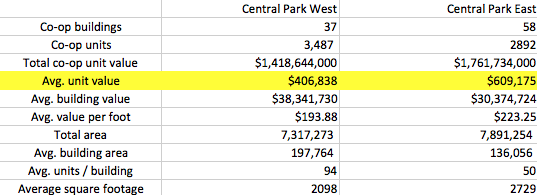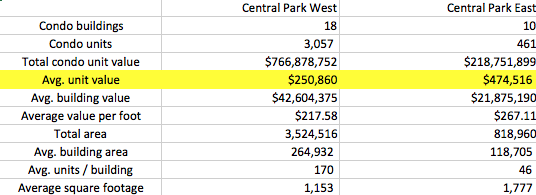Old money vs. older money. Lincoln Center vs. Lincoln Town Car. “Seinfeld” vs. “Gossip Girl”? There are many ways to Compare The Central Park West And Fifth Avenue, but when it comes to real estate, the numbers say it all.
Co-op and condominium units in Elevator Buildings On Fifth Avenue along Central Park are, according to the city, worth far more on average than their Central Park West counterparts. But because the West side has so many more units, the buildings on CPW are actually valued higher, The Real Deal‘s analysis of Department of Finance data found.
The current “market value” of the average parkside Fifth Avenue co-op unit stood at about $609,175 according to the records, compared to about $406,838 on CPW.
For condos, the average East side unit was valued by the city at $474,516, compared to about $250,860 for the average West side unit.
While they provide a clear and accurate comparison, these figures must be taken with a hefty grain of salt.
The estimated “market value” that the city assigns these units is typically much lower than a true market value, that is, the price a unit would likely sell for. Instead, the city’s numbers are based on a statistical model that measures condos and co-ops as if they were income-producing properties, such as rental units.
Part of the difference in per-unit value can be explained by differences in unit counts and relative unit sizes across the park.

Source: TRD analysis of NYC Department of Finance data
Both co-ops and condos were also significantly larger on average on the East side, with co-ops averaging about 2,729 square feet and condos about 1,777, compared to about 2,098 square feet and 1,153 square feet on average on the West side (note: these figures don’t account for non-residential space within buildings).

Source: TRD analysis of NYC Department of Finance data
But much of the rest of the story is cultural and historical.
“Fifth Avenue was always the primary avenue,” said Lee Jablin, architect and historic preservation expert, “it was the spine, or the root, of development going northward from Lower Manhattan.”
The avenue was traditionally home to members of New York City’s social elite, who in the later decades of the 19th century ordered their help to pack their things and head north from high society’s previous center of gravity around 34th Street.
What drew them? The park, of course.
“Speculation started in 1853 with just the thought of a park being built there,” Jablin said. When Central Park was established, it helped usher Fifth Avenue’s famous mansion-building era.
The roots of the Central Park West’s greatness were a bit more prosaic.
“Broadway was just a connection to Albany at the end of the day,” Jablin said of the west side thoroughfare.
Although the condos and co-ops on the Fifth Avenue side are today more valuable on average, there are many more of these apartments on Central Park West. Two-tower skyscrapers from the between-the-wars period, like the Emery Roth-designed San Remo and the Eldorado, find few rivals on Fifth Avenue, even though there are more individual co-op buildings there.
In total, Central Park West is home to 6,544 co-op and condo units in 55 elevator buildings, according to the data. The East side’s 68 buildings contain 3,353 units total.
“Construction really picks up on [Central Park West] with the 1929 zoning change, which brought in skyscraper design,” Jablin said. That change allowed a developer who could assemble lots totaling 30,000 square feet to build two towers on the same site. On Central Park West, there were many more of these sites available than on the more mansion and townhouse-thick Fifth Avenue, Jablin said.
Of the condos and co-ops that did go up on the East side, more were built with ultra-luxury amenities, such as dining services with in-house French chefs, compared to their cousin-buildings on Central Park West, said Kathy Sloane, a broker at Brown Harris Stevens.
Even so, the price gap could close at some point. “There’s a scarcity of available inventory on Central Park West,” she said, “so I think you’re going to so see those prices advancing.”
